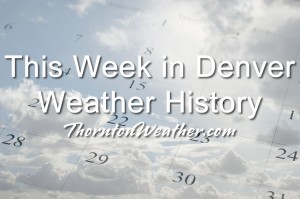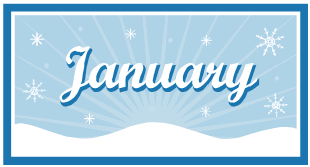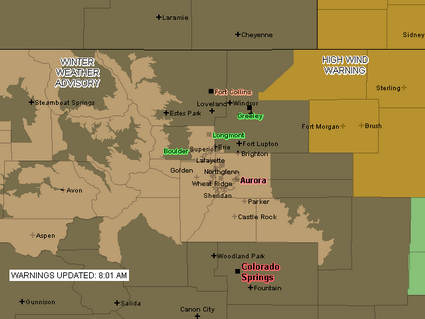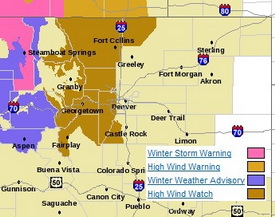
January in Colorado is known for two main weather conditions – cold and wind. Our look back at this week in Denver weather history shows why this reputation is well earned.
From the National Weather Service:
7-8
In 1911…gale force winds occurred in Boulder causing minor injuries.
In 1937…cold arctic air plunged temperatures below zero for an estimated 56 consecutive hours. Two temperature records were set. High temperatures of 8 degrees below zero on the 7th and 3 degrees on the 8th were record low maximum readings for those dates. Low temperatures plunged to 12 degrees below zero on the 7th and 11 degrees below zero on the 8th. Snowfall was 1.4 inches in downtown Denver.
In 1969…a violent evening windstorm struck Boulder and the adjacent foothills. A wind gust to 130 mph was recorded at the National Center for Atmospheric Research. Winds reached 96 mph in downtown Boulder. The Boulder airport wind recorder was blown away after measuring a wind gust to 80 mph. The windstorm caused over one million dollars in damage and one fatality in Boulder. About 25 homes in south Boulder had roofs blown off or were severely damaged. Roofs were blown off buildings housing scientific laboratories and offices of the Environmental Science Services Administration…now NOAA…in Boulder…and installations of several scientific measuring sites near Boulder received heavy damage. Grass fires driven by the high winds endangered many areas…but were controlled by volunteer firemen. One man died from injuries received when he was blown from a fire truck. One man was killed and another injured when the truck camper in which they were riding was blown off I-25 about 10 miles north of Denver. In the same area a mobile home and a truck trailer were blown off the highway and demolished. At least 20 people in the Boulder area received light to serious injuries from flying debris or from being blown into obstructions. Power lines and trees were downed over a wide area. Damage was relatively light in the city of Denver…where northwest winds gusted to 62 mph at Stapleton International Airport on the 8th. Many windows were broken in Arvada…Englewood…and Littleton. A 27-year-old fire lookout tower on Squaw Mountain…west of Denver…was blown away…and several radio relay towers at that location were toppled. Trucks were overturned near Georgetown. Mobile homes were overturned in several areas with occupants receiving injuries in some cases. The strong Chinook winds also brought warm weather. The maximum temperature of 69 degrees on the 7th broke the old record of 65 degrees set in 1948. The temperature also reached 65 degrees on the 8th…but was not a record.
In 1992…an intense blizzard buried eastern parts of metro Denver. At times snow fell at rates of 2 to 3 inches an hour. Winds increased from the north at speeds of 25 to 45 mph. Drifts of 4 to 8 feet were common. I-70 was closed east of Denver…and I-25 was closed from Denver south. Snowfall totals ranged from a couple of inches in the foothills west of Denver to as much as 2 feet on the east side of metro Denver. The heaviest snow fell on the 7th in a band from the northern suburbs of Westminster and Thornton through Aurora and east Denver to southeast of Parker. Snowfall totals included: 22 inches in southeast Aurora…14.8 inches at Stapleton International Airport…13 inches in Northglenn…10 inches in Parker…and 9 inches in Westminster. The 14.5 inches of snowfall measured on the 7th into the 8th is the greatest 24 hour snowfall ever recorded in the city during the month of January. North winds gusting to 46 mph caused much blowing snow at Stapleton International Airport.
In 2000…high winds developed in and near the Front Range foothills. The strongest winds were generally confined to foothills areas north of I-70. A wind gust to 76 mph was reported in Golden Gate Canyon. West winds gusted to 37 mph at Denver International Airport on the 8th.
7-10
In 1962…a major winter storm dumped 13.5 inches of snow on metro Denver. A foot of the snow fell on the 8th when northeast winds gusted to 30 mph. The storm was followed by an intense blast of very cold arctic air. Minimum temperature readings of 24 degrees below zero occurred on both the 9th and 10th. The temperature never reached above zero on the 9th when a maximum reading of 1 degree below zero was recorded. Temperatures were below zero for 37 consecutive hours.
8
In 1912…northwest winds were sustained to 40 mph with gusts to 45 mph in downtown Denver.
In 1971…wind gusts to 52 mph were recorded in downtown Boulder. Northwest winds gusted to 28 mph at Stapleton International Airport.
In 1990…high winds gusting from 50 to 90 mph along the Front Range produced much damage from blowing dust and gravel throughout the day. Wind gusts to 92 mph were recorded in the Table Mesa area of southwest Boulder. The winds caused sporadic power outages. Clouds of dust and gravel whipped by 70 to 90 mph gusts blinded commuters on the Denver-Boulder Turnpike near Broomfield during the morning rush hour. Flying gravel shattered windows on 50 vehicles parked near a Boulder high school. High winds were also blamed for partially dismantling a house under construction in Boulder…as well as toppling a number of fences…billboards…signs…and power poles. The strong cross-winds jack-knifed and overturned semi-tractor trailers on I-70 near Golden and just south of Boulder on State Highway 93. Several county airports were closed due to strong winds and blowing dust reducing visibilities. Wind delays up to 30 minutes occurred at Stapleton International Airport where west winds gusted to 48 mph. Eighty mph winds in Georgetown…Empire…and Idaho Springs were blamed for power and telephone outages. Windows were blown out of a sheriff’s car along I-70 east of Georgetown. The strong Chinook winds warmed the temperature to a high of 60 degrees in Denver.
In 2007…strong winds associated with an intense upper level jet…and a very strong surface pressure gradient…developed in and near the Front Range foothills. Peak wind gusts ranged from 77 mph to 115 mph. The strong winds coupled with freshly fallen snow resulted in whiteout conditions and several highway closures due to blowing and drifting snow. Road closures included: State Highway 93 between Golden and Boulder; State Highway 128 from Wadsworth Boulevard to State Highway 93; U.S. Highway 36…the Denver Boulder Turnpike from Broomfield to South Boulder Road; and State Highway 74 near Evergreen…between County Road 65 and Lewis Ridge Road. More than 100 people were stranded in their cars between Golden and Boulder as blowing and drifting snow made the highway impassable. Snow drifts along State Highway 93 were over 6 feet in depth. As a result… The American Red Cross opened a shelter at Arvada West High School for the stranded commuters. Up to twenty cars were also abandoned along the Diagonal Highway…between Boulder and Longmont. Thirty vehicles were stranded along State Highway 128. The high winds also caused intermittent power outages in Boulder. West winds gusted to 40 mph at Denver International Airport
Continue reading January 8 to January 14 – This Week in Denver Weather History



 Like any other month in Denver January can yield a wide variety of conditions. The month is pretty consistently our coldest but by the end of the month we do start to see temperatures slowly start to climb. Big time snow can and does happen but more often than not the month is quite dry – in fact it is our second driest month of the year.
Like any other month in Denver January can yield a wide variety of conditions. The month is pretty consistently our coldest but by the end of the month we do start to see temperatures slowly start to climb. Big time snow can and does happen but more often than not the month is quite dry – in fact it is our second driest month of the year.



